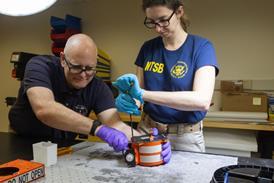Tim Furniss/WASHINGTON DC
A FAULTY TAPE recorder aboard NASA's $1.4 billion Galileo spacecraft could prevent much of its data and images being returned from the planet Jupiter this December, after its protracted six-year journey across the solar system.
Should it prove impossible to correct the fault, the political repercussions may force the cancellation of NASA's last large planetary exploration project, the Cassini, which is already under threat from Capitol Hill.
The Cassini - equipped with the European-built Huygens lander to explore the Saturnian moon, Titan - is planned for launch in October 1997, becoming the first craft to orbit the ringed planet in June 2004.
The Galileo mission, which began with deployment from the Space Shuttle Atlantis/STS34 in October 1989, has already been hit by the failure of the craft's high-gain antenna to deploy fully and by a stuck valve in the oxidiser system of the propulsion module (Flight International, 18-24 October).
NASA says that the data-storage tape recorder "...did not stop as expected after rewinding", following a picture-taking session on 11 October of Jupiter and its four major moons from a distance of 35.2 million kilometres. It is not clear whether the fault lies with the recorder hardware or software.
If it is the latter, then a major recovery effort may save the mission. Otherwise, only digital data will be returned and a "minimal number of images", using the limited amount of data and information which can be stored directly on the craft's main computer rather than on the recorder.
The number of images has already been reduced from a planned 50,000 to 1,500 by the high-gain antenna failure. Only the Galileo's low-data-rate low-gain antenna is usable.
The faulty recorder was placed on standby, while engineers at NASA's Jet Propulsion Laboratory (JPL) started to analyse the problem, while avoiding sending unnecessary commands to the Galileo. JPL does not expect to know the outcome until about 28 October, says William O'Neal, Galileo project manager.
The spacecraft enters orbit around Jupiter on 7 December. At the same time, an instrumented capsule will plunge into the Jovian atmosphere. The tape-recorder problem will not prevent digital-only data from the capsule being returned to Earth.
NASA's last major planetary mission, the Mars Observer, failed as the craft suffered a propellant leak and went out of control just before entering orbit in August 1993.
A major Galileo failure will therefore raise questions over the survival of the Cassini. It has already cost about $1.4 billion, and the total cost will be $3.4 billion by 2008 when the mission is complete.
"Congress cancelled the Super- collider when $8 billion had already been spent on the project, so you can never say that Cassini is safe," says Peter Ulrich, chief of the flight-programmes branch of the NASA Solar System Exploration division.
NASA has already embarked on "a series of faster, better, cheaper" planetary missions, costing about $500 million each, under the Discovery programme.
Source: Flight International























